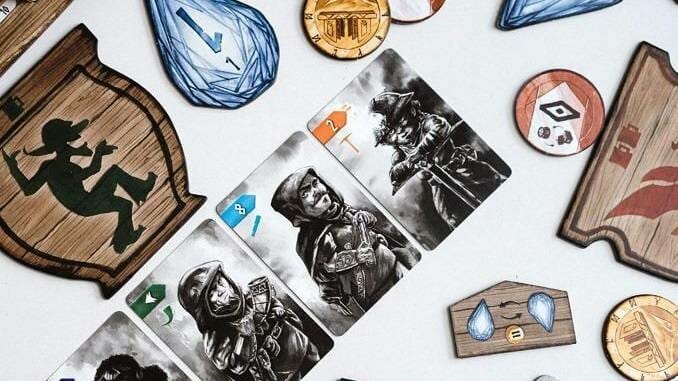Nidavellir made my ranking of the best board games of 2021, coming in at #3 for its clever bidding mechanic and quick gameplay. It offers a great mix of fun and strategy, just about perfect for a midweight game, with a high degree of player interaction as you compete with other players to ‘recruit’ cards of rough-and-ready dwarves from three taverns for your own armies.
Nidavellir is a set collection game at heart. In each of six or eight rounds, depending on the player count, you’ll get to bid on three rows of cards, and will end up with one card from each row as the bidding is resolved. That means you’ll end the game with 18 or 24 base cards from the bidding, plus some bonus cards you can earn along the way. Those cards, which depict different dwarves, come in five different colors, each of which scores differently and can earn you bonuses at midgame as well.
The bidding mechanic is by far the standout element of Nidavellir. Every player starts with the same five coins, worth 0, 2, 3, 4, and 5. The four coins with positive values work as you’d expect—players pick one coin to bid on each of the three rows (“taverns”), and players then choose cards from each tavern, going from the highest bid to the lowest. Ties are resolved by crystals that are passed around when used, so if you win a tie in this round, you won’t win the tie in the next round. You can bid the 0 coin on one of the three taverns, and if you do, you take a new coin worth the sum of the two coins you didn’t use in that round, returning the higher of the two back to the supply. The available coins go up to a value of 25, and they are limited—if the coin representing your sum isn’t available, you get to take the next higher one. Thus it’s often to your advantage not to bid your highest coins, because you’d rather have more powerful coins for the rest of the game.
The five colors are supposed to represent five different jobs that the dwarves in this kingdom can hold: explorers, hunters, blacksmiths, warriors, and miners. Blacksmiths (purple) and hunters (green) score based solely on how many cards you have in those colors. The value of each purple is equal to one plus the value of the last one, starting with value 3 for the first purple card you get. Your green cards are worth the square of the number of green cards you have. That means purples are worth more at the start, with 1-4 cards, but once you get six green cards or more, they pass purples. Explorers (blue) are simply worth their face values, which range from 5 to 11 points. Warriors (brown) are also worth their face values, but the player who has the most brown cards at game-end gets a bonus equal to the value of their largest coin—so it could be as much as 25 points. Miners (orange) are worth 0, 1, or 2 points each, but their scoring is the most complicated: Take the sum of all their face values and multiply it by the number of orange cards you have.
The way the scoring works, you can rack up huge point totals in purple and green, but doing so might mean skimping on some of the other colors, and then you don’t get to recruit Hero cards. Every time you collect a complete set of all five colors, you get to take a Hero card, most of which are unique. Some Hero cards show one of the five colors and give you additional points and/or some kind of power. Many of these cards count as several cards of that color, so they can run up your point total in that category. There are also three Hero cards that the rules recommend experienced players skip, as they are quite powerful; one of them, Uline, is not only overpowered in my opinion, but because it allows its owner to wait until other players have placed and revealed their bids for each tavern, it slows the game down. Placing a Hero card may complete another set of the five colors, allowing you to recruit yet another Hero. There are also bonuses at the game’s midpoint, awarded to any player who has a majority of cards in any of the five colors. These range from boosting the value of one of your coins by 5 to drawing a random card from the Age II deck (for the second half of the game) to getting a purple card that counts as two cards for scoring.
The game is best with three players, although it’s good with four or five. With two players, you still deal out three cards into each tavern, but bidding strategy is almost nonexistent, and that removes one of the game’s greatest strengths. With four or five players, you only play six rounds rather than eight, and I think the game benefits from the extra rounds—both because you’re building something and have more time to follow through, and because each round itself is fun. It moves quickly with its simultaneous bidding and the short number of turns, under an hour for any player count unless you have analysis paralysis people at your table (and why would you do that?). The rules themselves are simple enough for kids who’ve played some games before, but the amount of mental math in the scoring might put them at a disadvantage. Go grab yourself an Einstök and try this for your next game night.
Keith Law is the author of The Inside Game and Smart Baseball and a senior baseball writer for The Athletic. You can find his personal blog the dish, covering games, literature, and more, at meadowparty.com/blog.
